WAYNE CREED: Thank You Clelia — You Woke My Soul
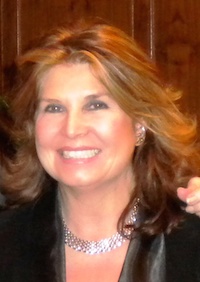
Retiring Arts Enter Director Clelia Sheppard
By WAYNE CREED
Cape Charles Wave
March 9, 2015
Some years ago, fairly new to Cape Charles, I walked into a cold Palace Theatre to take part in a poetry slam that was being hosted by Chris Bannon and the Friends of the Cape Charles Library. As usual I was unshaven, probably a bit hung over, and dressed in flannel and a wool beanie — I must have looked like one of the dock worker extras from On the Waterfront.
As I took a seat and waited for the reading to begin, two elegant, beautiful women entered and sat down. I thought to myself that they must have taken a wrong turn somewhere, or just had the time and place confused with some other. This was my first encounter with Sheila Cardano and her daughter, Clelia Sheppard.
I remember that afternoon well, as I read a story I had written about an odd Russian street performer and his beloved pug dog, and Ms. Cardano read one of her stories about a crazy squirrel. Life is serendipitous, contingent, and I always think of two events that actually saved my life: meeting my beautiful wife, and meeting Clelia Sheppard.
Growing up in West Haven, Connecticut, I remember my mother and grandmother taking me to the great New Haven theaters, and a love and fascination (appreciation) of the stage, whether drama, musical, or dance (Mom actually took me to NYC to see the great Edward Villella) stayed with me through high school and into college. After school, though, the passion kind of seeped away, replaced by other things such as work and career. In all, I had not thought of stepping onto the stage in close to 20 years.
How did Clelia Sheppard and her mom save my life? After meeting that first day, they somehow talked me into taking on a few roles in their Eastern Shore epic A Piece of Eden. By bringing me back into the fold of the theater, they woke up something that even I had forgotten how much I loved. In the years since then, I have had the pleasure to work with and learn from Clelia, but also meet some of my most wonderful friends (Dianne, Susan, Michael, Don, Mary Ann, Sherri, Keith, Amy, and the beautiful David Glowacki). I wish I could say my story is unique, but it is not. In fact, once you get to know Ms. Sheppard and her entire family, you will realize that it’s really quite common. [Read more…]
WAYNE CREED
Supervisors Missing Chance to Lower Flood Premiums
By WAYNE CREED
Cape Charles Wave
March 2, 2015
As the wonderful photography of Gertraud Fendler has documented, this winter has changed much of the Bay into a frozen pond. Despite the clean, white appearance, the actual condition of the water tells a different story. According to the Chesapeake Bay Foundation’s latest State of the Bay report (2014), the Bay is showing minor improvement, with Water quality indicator scores going up slightly. The problem with even this minor improvement is that the baseline has shifted so far towards the negative that incremental improvements such as this will hardly ever make a dent in the “real” health and quality of the Bay. The report also notes that Blue crabs and striped bass are showing signs of severe stress (due to pollution, diseases, overharvesting); again, these “metrics indicate a system still dangerously out of balance.” According to data from ChesapeakeBay.net, the abundance of spawning-age female blue crabs in the Chesapeake Bay decreased to 68.5 million in 2014, compared with 147 million in 2013.
Even as data continues to indicate an unhealthy Bay, and much of it pointing to the effects of human activity, it appears the Northampton County Planning Commission and Board of Supervisors are once again looking at removal of the Chesapeake Bay Protection Act from Seaside, using the rationale that it does not apply to the Seaside. This notion seems inconsistent with the original intent of the CBPA, which was envisioned to cover the Chesapeake Bay, its tributaries, and “other state waters.” According to the Virginia Department of Environmental Quality, the Bay Act program is designed to “improve water quality in the Chesapeake Bay and other waters of the State by requiring the use of effective land management and land use planning.” At the heart of the Bay Act is the concept that land can be used and developed to “minimize negative impacts on water quality.”
The first sentence of the Bay Act serves as a theme for the entire statute: “Healthy state and local economies and a healthy Chesapeake Bay are integrally related; balanced economic development and water quality protection are not mutually exclusive.”
The eloquent nature of the Bay Act is that it perceives that land should be used and developed to not just generate wealth for a few, but to minimize negative impacts on all water quality, which would benefit the majority of citizens (and even incubate economic development in the form of aquaculture and clean water tourism). In Virginia, the state designed the Bay Act to enhance water quality while at the same time allowing “reasonable development.” I guess this is the semantic argument, where a balancing act between state and local economic interests and water quality improvement is required. In Virginia the Bay Act puts the onus on local governments (who have the primary responsibility for land use decisions) to manage water quality, and “establishing a more specific relationship between water quality protection and local land use decision-making.” This quiet notion seems to be glaringly absent in the current proposed zoning. [Read more…]
WAYNE CREED Pays a Visit to United Poultry Concerns
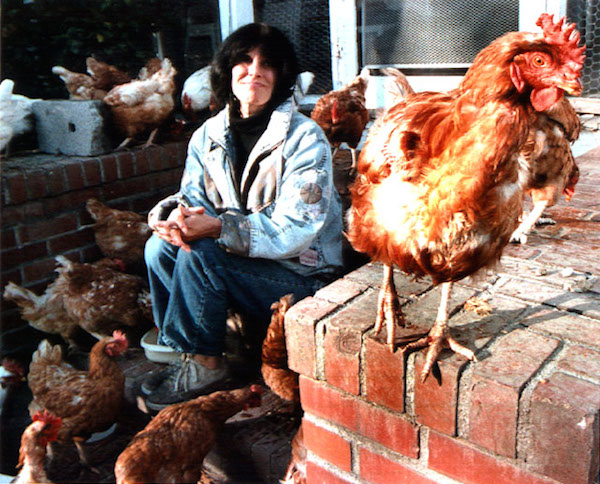
Karen Davis with some of her brood at United Poultry Concerns on Seaside Road. (Photo: Washington Post)
By WAYNE CREED
Cape Charles Wave
February 23, 2015
My roots are in the clay hills of northeastern Alabama, where for generations my forebears were basically subsistence farmers living on what the land would provide them. Mainly corn, cotton, apricots, and other rotational crops were supplemented with eggs (chickens produced year round). A flock of 100-120 chickens lived outside during the day, pecking the dirt for worms and insects, and in the evening returned to the safety of a fairly large corrugated metal and wire chicken house enclosure. This somewhat bucolic memory allowed me for so many years to perpetuate the myth of “cage free” or “free range” organic chicken farming in my own mind.
I would argue for the promotion of “organic” family chicken farming in Washington, DC, and Northern Virginia (where I lived for 25 years), as well as for expanded operations here on the Eastern Shore. That all changed a year ago. As I was traveling to work in Norfolk, I got behind a truckload of caged chickens. The thermometer in my car registered 18 degrees, and as I stopped at a traffic light, I could see each face, crammed in and waiting. I have never been much of an adherer to James Joycean epiphanies, but this was one. It was a realization that I had been very wrong about the myth of the family farm and the possibility of “humane” chicken farming. No matter what justification I tried to use, Morrisey was right: meat is murder — it’s unnecessary and just not possible to farm animals humanely. The end of the line would eventually lead to a cage in the back of a truck. I told myself I would try to no longer be party to this.
Almost one year later, I find myself on another cold morning traveling Seaside Road on the way to the chicken sanctuary and headquarters of United Poultry Concerns. Karen Davis, PhD, is the president of UPC, which she founded in 1990. UPC is a nonprofit organization “dedicated to the compassionate and respectful treatment of domestic fowl” and addresses the treatment of domestic fowl in “food production, science, education, entertainment, and human companionship situations.” [Read more…]
WAYNE CREED Takes on the Historic Review Board

House under construction at 404 Jefferson Avenue towers over its boarded-up neighbor. The Historic District Review Board vetoed sliding glass doors on the front of the house. (Wave photo)
EDITOR’S NOTE: Last week dauntless social critic Wayne Creed attended a meeting of the Cape Charles Historic District Review Board. His report and rant appear below.
By WAYNE CREED
Cape Charles Wave
February 2, 2015
The Historic District Review Board met January 29 to consider requested modifications to the Board’s earlier approval of plans for a new home at 404 Jefferson Avenue. Owner Gregory Manuel requested permission to add a second-story covered porch on the front of the house, a dormer on the west side, sliding glass doors to access the porch, and additional stairwell windows front and back.
Chairman Joe Fehrer called the session to order at 6 p.m.; however the applicant called to say that he was delayed due to an automobile accident. In the meantime, Mr. Fehrer observed that a large dormer had already been built, and framing for the porch and sliding glass doors had also been started. Those features had never been approved by the Board, which Fehrer said was “disappointing to me.”
Moments later the applicant rushed in, out of breath. Assistant Town Clerk Amanda Hurley, who was taking notes, stopped the meeting to bring him a glass of water. Fehrer then asked him, “Why would you build a dormer outside the scope of the original approval?”
“I don’t mean to overstep my bounds,” responded Manuel. “[Code Official Jeb Brady] said to stop. We did stop when Jeb asked. I will not make a habit of it.”
Fehrer noted that dormers had been approved by the Board in other instances, yet he was skeptical in this case. “They must meet historic guidelines,” he emphasized. Jeb Brady quickly added that there are several examples of dormers throughout the town.
Relative to the second-story covered porch, Fehrer pressed the applicant to explain the necessity of the new design. Manuel stated that he wanted to provide water views, and that “It is a small house. We wanted to increase the space.”
This is the first house in town to incorporate sliding glass doors on the front (façade) of the house, prompting Fehrer to respond that they did not appear to fit in with the historic character of the town. “They are not appropriate for the Historic District. I’m loath to make an approval that will set a precedent,” he said.
Manuel then asked Code Official Brady, “There are examples of this?” He then offered the Board some alternatives that they might find more palatable, everything from adding muttons to changing the design to incorporate French doors. Punctuating the exchange, Manuel’s cell phone rang and rang, as it would several more times during the meeting.
Chairman Fehrer held that he preferred one door and one window rather than sliding or double French doors, because “it would keep it in more of the character of the town.” Manuel retorted, “Have you seen the other houses next to it? Have you seen them?” [See above photo.] [Read more…]
WAYNE CREED Goes to a Town Council Meeting
EDITOR’S NOTE: In the absence of other reporting staff, Cape Charles’ most acerbic social critic, Wave columnist Wayne Creed, has recently donned a reportorial hat and dutifully recorded the actions of Northampton’s Board of Supervisors, which can be read in the news columns here and here. But in the column below, the indomitable Mr. Creed returns to his roots with an opinionated but highly informative commentary on Cape Charles Town Council’s first meeting of the new year.
By WAYNE CREED
Cape Charles Wave
January 19, 2015
With Christmas decorations ripped down, the sidewalks dark and lonely, the night cold and wet, the lights were turned on inside the Town Civic Center January 15 in order to conduct the first Town Council Regular Meeting of the New Year. Aside from two members of news media (Cape Charles Wave and Eastern Shore Post), only two other constituents braved the raw weather to attend. Mayor Proto himself arrived nearly 30 minutes late.
Town Council voted to request the Virginia Port Authority to carry over to the new year several grants previously awarded for harbor improvements. This includes $645,000 for offshore breakwaters and $185,000 for a wave attenuator and dock improvements. The VPA has altered the terms to a 75%-25% match, making the proposal more fiscally attractive. Local matching funds must still be identified for these projects. Councilman Steve Bennett aggressively questioned Harbormaster Smitty Dize in what appeared to be a leading manner, attempting to get Mr. Dize to acknowledge, or at least provide a modicum of actual requirements that might justify the request for funds.
“Are there no plans to spend the money (we have)? No contracts have been awarded?”
Mr. Dize only responded, “I’m with you,” and “the VPA likes Cape Charles. We spend their money.”
The motion to have Mayor Proto write a letter requesting the funds passed unanimously (Councilman Wendell was absent). There was no discussion by Council regarding who would actually write, edit, or approve the letter Mayor Proto is required to sign. [Read more…]
WAYNE CREED: Thoughts on Two Years Without a Net
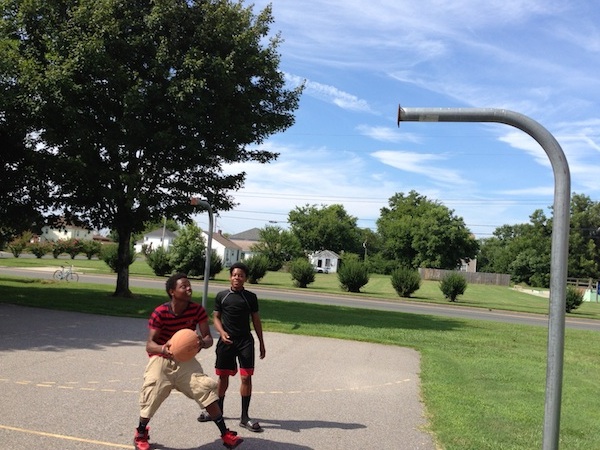
Town Manager Bob Panek ordered basketball backboards and nets removed December 26, 2012, for “safekeeping.” The Wave has been running this poignant picture ever since.
By WAYNE CREED
January 5, 2015
As the holidays end, the realization that winter is really here finally begins to sink in. The colder air and diminishing light began to incubate my seasonal affective funk. This growing malaise is compounded by the fact that my son’s fall sports — JJV football and Shore Soccer — are also over. Sitting on my front porch steps, I’m watching him, in a cold, light rain, dribble up and down the wet sidewalk. One way to avoid the inevitable winter depression is to stay as busy as possible; self-tasking, I try to help Joey begin the transition to winter sports: basketball. Going over the fundamentals, defense by Kevin Garnet and Gary Payton, workout routines by Steve Nash — this kind of work is good, but not fun; he still really wants to go out and play for real. Being an old Knicks fan, I try and remind him of what Bill Bradley used to say, “When you’re not out practicing, someone else is. And when you meet that person, he’s going to beat you.”
True, yet even Bill would have to admit it’s tough here for ballers, since there isn’t anywhere in Cape Charles to truly practice or play (Cape Charles Baptist Church has one goal in a small area for every player in and around town. The backboard has already been crashed once). The outside courts at the old school, perfect for the urban ¾ game, have been taken down, and the beautiful old court inside is being chopped up and turned into apartments.
A few weeks ago, the Wave published a story about the developer of the old school. As usual, there were several interesting comments, but one really struck me. This person said in his comment that he really didn’t have a dog in the fight, but was against the town keeping the courts public. Yet in the same breath he said he hoped the folks that wanted a “community center” would eventually get one. I had to wonder just what it would have taken for him to have a dog in the fight. From my perspective, it was easy because my dog was mainly sports — indoor and outdoor. Without the gym and outside courts, I just don’t see how you can even pursue the concept of a “community center.” [Read more…]
Progressive Dinner Tour, A Christmas Carol Herald Christmas in Cape Charles
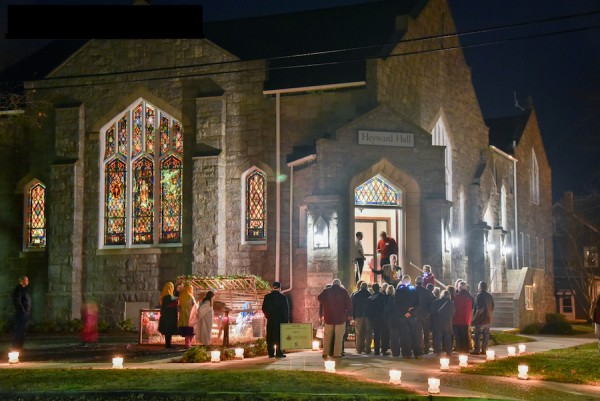
Cape Charles Christian School with restored stained glass windows was most dramatic stop on this year’s Progressive Dinner Tour. (Photo: Chris Glennon)
By WAYNE CREED
December 22, 2014
Living in Cape Charles is always great no matter the season, whether spring, summer, fall or winter. But Christmas time in Cape Charles is always a special time that sets itself apart from the rest of the year. The streets are lined with decorations, Smitty has his crab pot tree at the harbor, and the shops are decorated as cheerfully as any in Ghent or Old Town Alexandria.
This season, I was fortunate to be able to be part of two wonderful Christmas events: acting in short skit at one of the stops along the Progressive Dinner Tour, and acting and directing in the Palace Theatre’s A Christmas Carol.
The Progressive Dinner Tour’s theme this year was “Christmas by the Bay,” where a yacht full of rich folks are stranded in the harbor, and are forced to endure the holidays in this little bayside village. Of course they, like all of us, fell in love with Cape Charles, and wind up buying a home here. My role in this little drama was to play the saucy Mrs. Lambertson, along with Michael Flannigan as the sea captain and Sagre Strutzman as the chef. I don’t mean to sound immodest, but on this evening I was certainly the sexiest woman in Cape Charles (and moving forward, possibly Cape Charles’ new “I”’ girl).
I have been involved in several Progressive dinners in the past, yet it seems like this year was truly one of the best. Carol Evans and the Chamber of Commerce, along with all the volunteers, should be commended for designing such an elegant, yet streamlined evening (we have seen some of these go well into the night). I wish I could review each and every location but I can only give a first person account from where I was working, at the beautiful Sea Gate Bed and Breakfast. Mr. Bannon did a wonderful job decorating for the occasion, filling each space from the Florida Room to the Peach, Blue, or Yellow bedrooms with ample color and holiday cheer. [Read more…]
WAYNE CREED
Great Atlantic Sturgeon Making Comeback
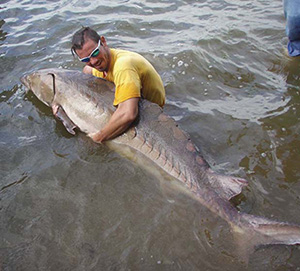
One of the first sturgeon caught in the James River in decades, this specimen measured over 7 feet long and weighed 300 pounds. (Photo: Virginia Commonwealth University)
By WAYNE CREED
November 10, 2014
In 2012, the National Marine Fisheries Service listed the Great Atlantic Sturgeon under the Endangered Species Act. This is usually bad news, but since sightings and spawning grounds were so rare, the fact that there was enough sturgeon left to even warrant the declaration is a good thing. Two years later, we find that they are once again spawning in the Chesapeake Bay just outside the James River.
A bit of a homecoming, the fish was critical to the first English settlement at Jamestown, and was noted by inhabitants as the “founding fish.” Historians and archaeologists unearthing the history of the Jamestown colony have called the sturgeon “The fish that saved Jamestown.” During a period known as “The Starving Time,” it was the one food source available to the English colonists that kept them alive. Because of their familiarity with the sturgeon species from the Thames River in England, they knew how to catch and cook the fish. [Read more…]



















